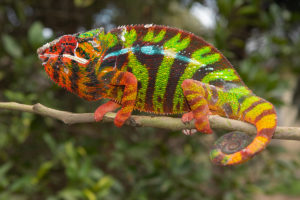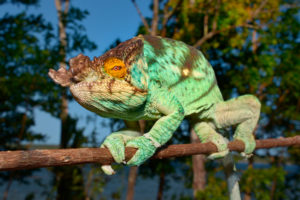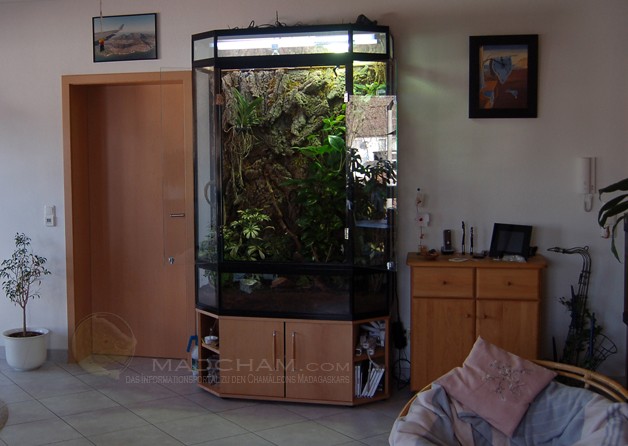
Glass

Glass cages with screen top
Cages made of glass belong to the oldest in keeping reptiles, and have been staying keepers in good stead for years. Unfortunately, many standard glass cages in common shops are not suitable for keeping chameleons due to their bad ventilation. That means before using a glass terrarium for a chameleon, you have to add ventilation mesh and convert the original cage into a chameleon-appropriate one. In most cases, people remove the top and one pane and replace it with aluminium screens. We have been using modified glass terrariums as quarantine cages and for keeping small species such as Brookesia stumpffi.
Advantages:
- very good visibility
- very easy to clean & sanitise, therefore reusable
- very translucent to let more light in
- generally waterproof
- affordable price
Disadvantages:
- The lid must be replaced with gauze/mesh, as glass does not allow UVB radiation to pass through. Perforated sheets in the lid absorb too much light and UVB radiation, so a cage cannot be used this way.
- Modification or customisation necessary – it is rather difficult to retrofit large ventilation areas on the sides of standard tanks. Sliding doors can be easily replaced with narrow aluminium or wooden frames with gauze.
- Relatively high weight for larger terrariums
- Some chameleons react aggressively to their reflection. The glass must then be covered at least temporarily.
Polystyrene or styrofoam

Quarantine cage made of polystyrene
Especially hobby do-it-yourselfer love to create their own terrarium out of polystyrene or similar material, but it never became prevalent in chameleon keeping. If you want to invest a lot of time and efforts and have a creative streak, you will be able to get pretty results with hairdrier and other tools. But in most cases, these self-built back panels and terrarium walls do not reach the original expectations, especially in terms of optics.
Advantages:
- very cheap material
- very lightweight
- can be built exactly after personal ideas
- self-made look
Disadvantages:
- need to be coated several times (epoxy resin, tile cement)
- very difficult to clean and disinfect (almost impossible)
- enormous amount of time needed
- self-made look
- sometimes unstable
OSB (oriented strand boards)

Terrarium made of OSB, here used for locusts
Especially beginners in keeping chameleons like these kind of cage material, because it is cheap and easy to work with. You can get OSB in every DIY-shop. Even ready bought OSB terrariums can be easily changed or converted into chameleon-appropriate style. It is a big disadvantage that you have to coat OSB with epoxy resin or similar seals several times, otherwise the high humidity of a chameleon terrarium will make the OSB swell up. Partially, this might lead to much more intense costs than thought before. Optically, we do not like to have OSB cages inside our living rooms.
Advantages:
- cheap material
- DIY centers can cut all boards individually
- dimensionally stable
- ventilation areas can be cut out even in the final cage
Disadvantages:
- -difficult or impossible to clean and disinfect
- Not waterproof: all panels must be sealed
- unsightly appearance / masking the OSB with decorative film rarely works cleanly

Cages made of rigid foam boards
Rigid foam boards
Forex is a mostly white hard foam board that has become very popular among chameleon keepers and other reptile enthusiasts in recent years. The advantages of an elegant look in the living area, good cleaning options and low weight are offset by the high cost of purchase. Forex is also a very soft building material, which can pose problems in terms of stability.
Advantages:
- very lightweight, easy to transport
- clean, pretty look
- easy to clean and disinfect
- easy to cut and work with
- Simple adhesive connections are sufficient for small cages
- can be combined with alu profiles for larger cages
Disadvantages:
- very soft and flexible material, only useful to use alone up to a certain terrarium size
- Relatively expensive
- can only be resold to a very limited extent/very poorly
Aluminium profiles
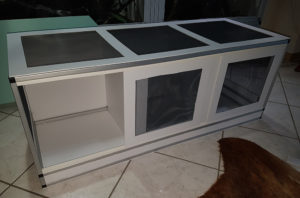 Terrariums made of aluminium profiles are probably the best choice of building materials in terrarium construction and leave almost nothing to be desired, as almost any shape, appearance and size can be realised. The profiles are inserted into each other using connectors. When properly installed, the finished aluminium frames are almost indestructible, very rigid and permanently dimensionally stable. They can be used to make entire terrarium walls as well as individual terrariums. The profiles are available in various colours so that they can be used in living areas without any problems. Aluminium profiles can be used with any material, e.g. glass, rigid foam panels or aluminium composite panels.
Terrariums made of aluminium profiles are probably the best choice of building materials in terrarium construction and leave almost nothing to be desired, as almost any shape, appearance and size can be realised. The profiles are inserted into each other using connectors. When properly installed, the finished aluminium frames are almost indestructible, very rigid and permanently dimensionally stable. They can be used to make entire terrarium walls as well as individual terrariums. The profiles are available in various colours so that they can be used in living areas without any problems. Aluminium profiles can be used with any material, e.g. glass, rigid foam panels or aluminium composite panels.
Advantages:
- very stable and robust
- leightweight
- made for the long-term
- hardly loss of value over time
- very nice look
Disadvantages:
- Significantly more expensive than a few years ago / most expensive variant
- Customised products can hardly be resold at the moment
Aluminium composte panels + aluminium profiles
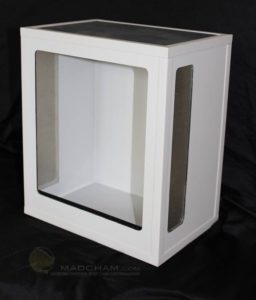 Terrariums made of aluminium profiles and white aluminium composite panels have an elegant look that is very similar to forex terrariums. In terms of stability, size and durability, aluminium composite offers several advantages over forex. However, the terrarium is also considerably heavier with aluminium composite panels than with hard foam panels. The cost advantage that aluminium composite panels had over rigid foam panels until a few years ago is virtually non-existent today.
Terrariums made of aluminium profiles and white aluminium composite panels have an elegant look that is very similar to forex terrariums. In terms of stability, size and durability, aluminium composite offers several advantages over forex. However, the terrarium is also considerably heavier with aluminium composite panels than with hard foam panels. The cost advantage that aluminium composite panels had over rigid foam panels until a few years ago is virtually non-existent today.
Advantages:
- clean, elegant look
- dimensionally stable even with 200 cm heights
- easy to clean and disinfect
Disadvantages:
- Significantly more expensive than a few years ago / most expensive variant
- Customised products can hardly be resold at the moment

